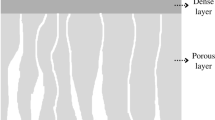Abstract
Clarification is one of the main steps in producing glycerin from glycerin–rich solution (namely sweetwater) in oleo-chemical industry. In this study, ZnO nanoparticles (9–12 nm in diameter) were incorporated into polysulfone (PSf) membranes to improve the membrane antifouling properties toward the fatty acids in sweetwater. The hybrid membranes were fabricated through wet phase inversion method. The modified membranes exhibited better water permeability, membrane surface hydrophilicity (improvement from 82° to 62.1°) and resistance toward fouling by fatty acids. In this study, the best membrane was obtained in the presence of 3% of ZnO nanoparticles, which showed good fouling resistance, high solution flux and a very high rejection of fatty acids (≥80%) in comparison with the pure PSf membranes, at the same experimental conditions. The enhanced membrane performances during the clarification of sweetwater were attributed to the unique properties of ZnO nanoparticles that were uniformly dispersed in the PSf structures.





Similar content being viewed by others
References
Amin INHM, Mohammad AW, Markom M et al (2010a) Flux decline study during ultrafiltration of glycerin-rich fatty acid solutions. J Memb Sci 351:75–86. doi:10.1016/j.memsci.2010.01.033
Amin INHM, Mohammad AW, Markom M, Peng LC (2010b) Effects of palm oil-based fatty acids on fouling of ultrafiltration membranes during the clarification of glycerin-rich solution. J Food Eng 101:264–272. doi:10.1016/j.jfoodeng.2010.07.006
Ba-Abbad MM, Kadhum AAH, Mohamad AB, Takriff MS, Sopian K (2012) Synthesis and catalytic activity of TiO2 nanoparticles for photochemical oxidation of concentrated chlorophenols under direct solar radiation. Int J Electrochem Sci 7:4871–4888
Ba-Abbad MM, Kadhum AAH, Bakar Mohamad A et al (2013) The effect of process parameters on the size of ZnO nanoparticles synthesized via the sol–gel technique. J Alloys Compd 550:63–70
Balta S, Sotto A, Luis P et al (2012) A new outlook on membrane enhancement with nanoparticles: the alternative of ZnO. J Memb Sci 389:155–161. doi:10.1016/j.memsci.2011.10.025
Buenemann T, Oudejans JC, Gamba P, Rampi A (1991) US Patent No 4,990,695. U.S. Patent and Trademark Office, Washington, DC
Chakrabarty B, Ghoshal AK, Purkait MKK (2008) Effect of molecular weight of PEG on membrane morphology and transport properties. J Memb Sci 309:209–221. doi:10.1016/j.memsci.2007.10.027
Chung YT, Mahmoudi E, Mohammad AW et al (2017) Development of polysulfone-nanohybrid membranes using ZnO–GO composite for enhanced antifouling and antibacterial control. Desalination 402:123–132. doi:10.1016/j.desal.2016.09.030
Howe KJ, Ishida KP, Clark M (2002) Use of ATR/FTIR spectrometry to study fouling of microfiltration membranes by natural waters. Desalination 147:251–255
Juang R, Chen H, Chen Y (2008) Membrane fouling and resistance analysis in dead-end ultrafiltration of Bacillus subtilis fermentation broths. Sep Purif Technol 63:531–538. doi:10.1016/j.seppur.2008.06.011
Leo CP, Cathie Lee WP, Ahmad AL, Mohammad AW (2012) Polysulfone membranes blended with ZnO nanoparticles for reducing fouling by oleic acid. Sep Purif Technol 89:51–56. doi:10.1016/j.seppur.2012.01.002
Mah S-K, Leo CP, Wu TY, Chai S-P (2012) A feasibility investigation on ultrafiltration of palm oil and oleic acid removal from glycerin solutions: flux decline, fouling pattern, rejection and membrane characterizations. J Memb Sci 389:245–256. doi:10.1016/j.memsci.2011.10.037
Mahmoudi E, Ng LY, Ba-Abbad MM, Mohammad AWW (2015) Novel nanohybrid polysulfone membrane embedded with silver nanoparticles on graphene oxide nanoplates. Chem Eng J 277:1–10. doi:10.1016/j.cej.2015.04.107
Martins PPF, Ito VVM, Batistella CB, Maciel MRW (2006) Free fatty acid separation from vegetable oil deodorizer distillate using molecular distillation process. Sep Purif Technol 48:78–84. doi:10.1016/j.seppur.2005.07.028
Ng LY, Leo CP, Mohammad AW (2011) Optimizing the incorporation of silica nanoparticles in polysulfone/poly (vinyl alcohol) membranes with response surface methodology. J Appl Polym Sci 121:1804–1814. doi:10.1002/app
Oldani M, Schock G (1989) Characterization of ultrafiltration membranes by infrared spectroscopy, ESCA, and contact angle measurements. J Memb Sci 43:243–258
Seman M, Khayet M, Hilal N (2012) Comparison of two different UV-grafted nanofiltration membranes prepared for reduction of humic acid fouling using acrylic acid and N-. Desalination 287:19–29
Wang T, Zhang Y, Li G, Li H (2009) Preparation and characterization of alumina hollow fiber membranes. Front Chem Eng China 3:265–271
Wang N, Ji S, Li J et al (2014) Poly(vinyl alcohol)–graphene oxide nanohybrid “pore-filling” membrane for pervaporation of toluene/n-heptane mixtures. J Memb Sci 455:113–120. doi:10.1016/j.memsci.2013.12.023
Wu H, Mansouri J, Chen V (2013) Silica nanoparticles as carriers of antifouling ligands for PVDF ultrafiltration membranes. J Memb Sci 443:135–151
Yan L, Li YS, Xiang CB, Xianda S (2006) Effect of nano-sized Al2O3-particle addition on PVDF ultrafiltration membrane performance. J Memb Sci 276:162–167. doi:10.1016/j.memsci.2005.09.044
Yang Y, Zhang H, Wang P et al (2007) The influence of nano-sized TiO2 fillers on the morphologies and properties of PSF UF membrane. J Memb Sci 288:231–238. doi:10.1016/j.memsci.2006.11.019
Yang JM, Chiang CY, Wang HZ, Yang CC (2009) Two step modification of poly(vinyl alcohol) by UV radiation with 2-hydroxy ethyl methacrylate and sol–gel process for the application of polymer electrolyte membrane. J Memb Sci 341:186–194. doi:10.1016/j.memsci.2009.06.004
Zinadini S, Zinatizadeh AA, Rahimi M et al (2014) Preparation of a novel antifouling mixed matrix PES membrane by embedding graphene oxide nanoplates. J Memb Sci 453:292–301. doi:10.1016/j.memsci.2013.10.070
Acknowledgements
The Grant ICONIC-2014-002 is acknowledged for the financial support of this project.
Author information
Authors and Affiliations
Corresponding author
Additional information
Editorial responsibility: Binbin Huang.
Rights and permissions
About this article
Cite this article
Mahmoudi, E., Ng, L.Y., Mohammad, A.W. et al. Enhancement of polysulfone membrane with integrated ZnO nanoparticles for the clarification of sweetwater. Int. J. Environ. Sci. Technol. 15, 561–570 (2018). https://doi.org/10.1007/s13762-017-1413-0
Received:
Revised:
Accepted:
Published:
Issue Date:
DOI: https://doi.org/10.1007/s13762-017-1413-0




